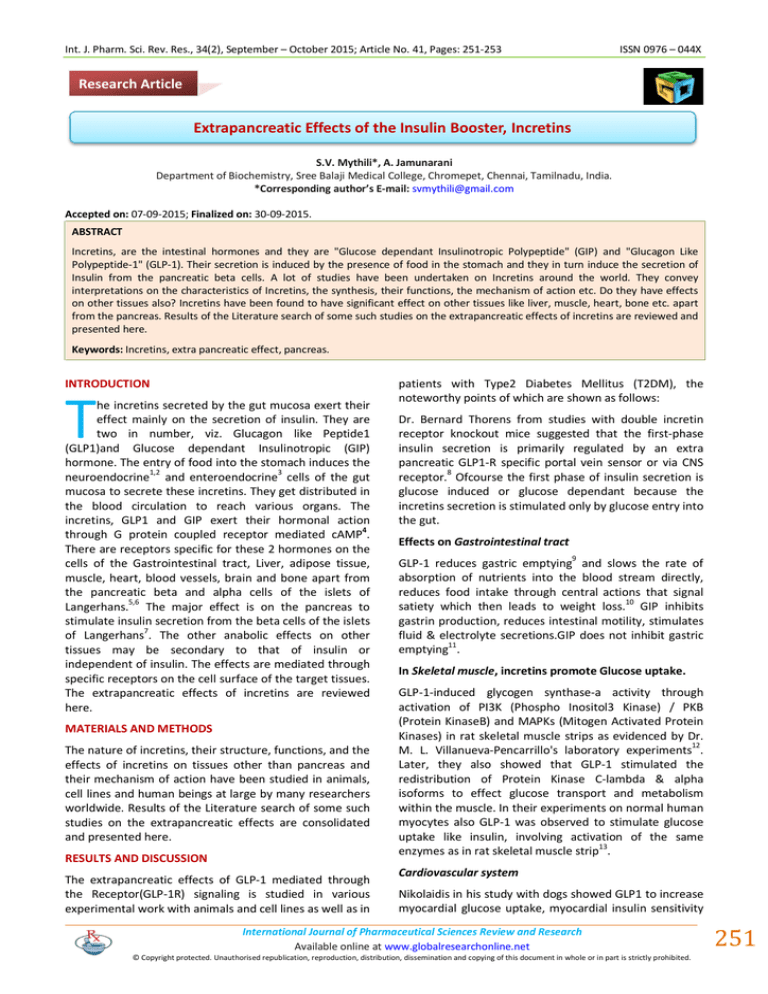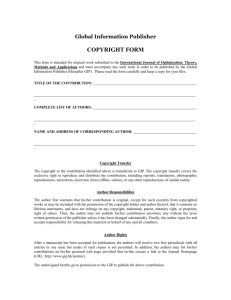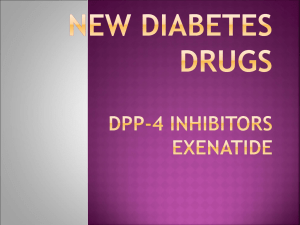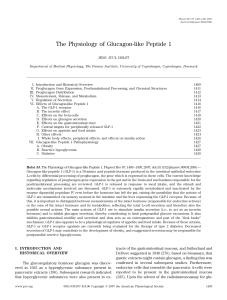Document 13310687
advertisement

Int. J. Pharm. Sci. Rev. Res., 34(2), September – October 2015; Article No. 41, Pages: 251-253 ISSN 0976 – 044X Research Article Extrapancreatic Effects of the Insulin Booster, Incretins S.V. Mythili*, A. Jamunarani Department of Biochemistry, Sree Balaji Medical College, Chromepet, Chennai, Tamilnadu, India. *Corresponding author’s E-mail: svmythili@gmail.com Accepted on: 07-09-2015; Finalized on: 30-09-2015. ABSTRACT Incretins, are the intestinal hormones and they are "Glucose dependant Insulinotropic Polypeptide" (GIP) and "Glucagon Like Polypeptide-1" (GLP-1). Their secretion is induced by the presence of food in the stomach and they in turn induce the secretion of Insulin from the pancreatic beta cells. A lot of studies have been undertaken on Incretins around the world. They convey interpretations on the characteristics of Incretins, the synthesis, their functions, the mechanism of action etc. Do they have effects on other tissues also? Incretins have been found to have significant effect on other tissues like liver, muscle, heart, bone etc. apart from the pancreas. Results of the Literature search of some such studies on the extrapancreatic effects of incretins are reviewed and presented here. Keywords: Incretins, extra pancreatic effect, pancreas. INTRODUCTION T he incretins secreted by the gut mucosa exert their effect mainly on the secretion of insulin. They are two in number, viz. Glucagon like Peptide1 (GLP1)and Glucose dependant Insulinotropic (GIP) hormone. The entry of food into the stomach induces the neuroendocrine1,2 and enteroendocrine3 cells of the gut mucosa to secrete these incretins. They get distributed in the blood circulation to reach various organs. The incretins, GLP1 and GIP exert their hormonal action through G protein coupled receptor mediated cAMP4. There are receptors specific for these 2 hormones on the cells of the Gastrointestinal tract, Liver, adipose tissue, muscle, heart, blood vessels, brain and bone apart from the pancreatic beta and alpha cells of the islets of Langerhans.5,6 The major effect is on the pancreas to stimulate insulin secretion from the beta cells of the islets of Langerhans7. The other anabolic effects on other tissues may be secondary to that of insulin or independent of insulin. The effects are mediated through specific receptors on the cell surface of the target tissues. The extrapancreatic effects of incretins are reviewed here. MATERIALS AND METHODS The nature of incretins, their structure, functions, and the effects of incretins on tissues other than pancreas and their mechanism of action have been studied in animals, cell lines and human beings at large by many researchers worldwide. Results of the Literature search of some such studies on the extrapancreatic effects are consolidated and presented here. RESULTS AND DISCUSSION The extrapancreatic effects of GLP-1 mediated through the Receptor(GLP-1R) signaling is studied in various experimental work with animals and cell lines as well as in patients with Type2 Diabetes Mellitus (T2DM), the noteworthy points of which are shown as follows: Dr. Bernard Thorens from studies with double incretin receptor knockout mice suggested that the first-phase insulin secretion is primarily regulated by an extra pancreatic GLP1-R specific portal vein sensor or via CNS receptor.8 Ofcourse the first phase of insulin secretion is glucose induced or glucose dependant because the incretins secretion is stimulated only by glucose entry into the gut. Effects on Gastrointestinal tract GLP-1 reduces gastric emptying9 and slows the rate of absorption of nutrients into the blood stream directly, reduces food intake through central actions that signal satiety which then leads to weight loss.10 GIP inhibits gastrin production, reduces intestinal motility, stimulates fluid & electrolyte secretions.GIP does not inhibit gastric emptying11. In Skeletal muscle, incretins promote Glucose uptake. GLP-1-induced glycogen synthase-a activity through activation of PI3K (Phospho Inositol3 Kinase) / PKB (Protein KinaseB) and MAPKs (Mitogen Activated Protein Kinases) in rat skeletal muscle strips as evidenced by Dr. 12 M. L. Villanueva-Pencarrillo's laboratory experiments . Later, they also showed that GLP-1 stimulated the redistribution of Protein Kinase C-lambda & alpha isoforms to effect glucose transport and metabolism within the muscle. In their experiments on normal human myocytes also GLP-1 was observed to stimulate glucose uptake like insulin, involving activation of the same enzymes as in rat skeletal muscle strip13. Cardiovascular system Nikolaidis in his study with dogs showed GLP1 to increase myocardial glucose uptake, myocardial insulin sensitivity International Journal of Pharmaceutical Sciences Review and Research Available online at www.globalresearchonline.net © Copyright protected. Unauthorised republication, reproduction, distribution, dissemination and copying of this document in whole or in part is strictly prohibited. 251 © Copyright pro Int. J. Pharm. Sci. Rev. Res., 34(2), September – October 2015; Article No. 41, Pages: 251-253 14 and to improve left ventricular function. GLP1 has protective effect on myocardium mediated through cAMP activation of antiapoptic signalling pathways of Phosphoinositide 3kinase and Mitogen Activated Protein 15 Kinase as studied in rat heart . This is seen in myocardial 16 infarct patient also . It improves endothelial function in the blood vessels17. Adipocytes Both GLP1 (7-36) amide and GIP stimulate fatty acid 18 synthesis in adipose tissue . In normal rat adipocytes, GLP-1 increased the activity of PI3K, p44 and p42 MAPKs and possibly PKC, to stimulate glucose uptake. GLP-1 has both lipogenic action by increasing PI3K and MAPKs activity, and lipolytic effect through MAP kinases and PKC.19 GIP also regulates fat metabolism in adipocytes, including stimulation of the activity of lipoprotein lipase, fatty acid synthesis and incorporation20 but, reduces the 21 lipolytic effects of glucagon . Hepatocytes In rat hepatocytes, stimulation of glycogen synthase was induced by GLP1 through activation of phosphatidylinositol 3-kinase (PI3K)/protein kinase B (PKB), protein kinase C (PKC) and protein phosphatase 1(PP-1)12,22. GLP-1 promotes glycogen accumulation through activation of glycogen synthase-A & inhibition of glycogen phosphorylase-A. Glucagon when added to the media, reduced the accumulation of glycogen. This was also accompanied by a significant reduction in cAMP.23 Acknowledgement: I wish to thank Dr.P. Saikumar, Vice Principal, of Sree Balaji Medical College & Hospital for his persistent encouragement. I gratefully acknowledge all the Authors whose articles I have used as references, for their awesome work which only evinced my interest to do the Literature search & write this review. REFERENCES 1. Buffa R, Polak J. M, Pearse A. G. E., Solcia E, Grimelius L, Capella C. Identification of the intestinal cell storing gastric inhibitory peptide. Histochemistry. 43(3), 1975, 249-255. 2. Alison M J, Buchan, Julia M Polak, Capella C, Solcia E, Pearse A.G.E. Electronimmunocytochemical evidence for the K cell localization of Gastric Inhibitory Polypeptide (GIP) in man. Histochemistry. 56, 1978, 37-44. 3. Eissele R, Göke R, Willemer S, Harthus HP, Vermeer H, Arnold R, Göke B. Glucagon-like peptide-1 cells in the gastrointestinal tract and pancreas of rat, pig and man. Eur J Clin Invest. 22(4), 1992, 283-91. 4. Drucker DJ, Philippe J, Mojsov S, Chick WL, Habener JF. Glucagon-like peptide I stimulates insulin gene expression and increases cyclic AMP levels in a rat islet cell line. Proc Natl Acad Sci U S A. 84, 1987, 3434–3438. 5. Usdin T B, Mezey E, Button D C, Brownstein M J, Bonner T I. Gastric inhibitory polypeptide receptor, a member of the secretin-vasoactive intestinal peptide receptor family, is widely distributed in peripheral organs and the brain. Endocrinology. 133(6), 1993, 2861-2870. 6. Wei Y, Mojsov S. Tissue-specific expression of the human receptor for glucagon-like peptide-I: brain, heart and pancreatic forms have the same deduced amino acid sequences. 358(3), 1995, 219-24. 7. La Barre J. Sur les possibilities d'un traitement du diabete par l'incretine. Bulletin de IAcademie royale de medicine de Belgique 2, 1932, 632-634. 8. Thorens B. Lessons learned from glucose-incretin receptor knockout mice. Symposium: incretin regulation of beta cell function and survival. Program and abstracts of the European Association for the Study of Diabetes 41st Annual Meeting; September 12-15, 2005; Athens, Greece. 9. Wishart JM, Horowitz M, Morris HA, Jones KL, Nauck MA. Relation between gastric emptying of glucose and plasma concentrations of glucagon-like peptide-1. Peptides. 19, 1998, 1049–1053. GIP in bone Christine and his team compared the effect of total inhibition of GIP signaling on the volume, microarchitecture and quality of trabecular bone in GIP receptor (GIPR) knockout mice by microCT and histomorphometry. The results showed an increase in the number of bone resorbing osteoclasts and also the trabecular bone mass and number with a reduction in mature collagen and mineralization of the bone matrix and bone quality compared to wild type mice24. GIP was shown to reduce etoposide-induced apoptosis of osteoblasts in an experiment with cell line. Thus, GIP through its direct cytoprotective effect on osteoblasts may prevent decreases in density of bone. GIP receptors are present on osteoblasts, osteocytes and osteoclasts. GIP also inhibited bone resorptive activity of osteoclasts.25 CONCLUSION The incretins namely, GIP and GLP1 are the gut hormones that act to boost the glucose dependant insulin secretion from the beta cells of the islets of Langerhans and depress the secretion of glucagon from alpha cells. Apart from this major effect, they also act on other extrapancreatic tissues like liver, gastrointestinal tract, heart, blood vessels, bone and brain to produce mostly anabolic effects in conjunction with that of insulin. ISSN 0976 – 044X 10. Nauck MA, Niedereichholz U, Ettler R, Holst JJ, Orskov C, Ritzel R, Schmiegel WH . Glucagon-like peptide 1 inhibition of gastric emptying outweighs its insulinotropic effects in healthy humans. Am J Physiol. 273(5 Pt 1); 1997:E981. PMID: 9374685 11. Edholm T, Degerblad M, Grybäck P, Hilsted L, Holst J. J, Jacobsson H, Efendic S, Schmidt PT, Hellström PM. Differential incretin effects of GIP and GLP-1 on gastric emptying, appetite, and insulin-glucose homeostasis. Neurogastroenterology & Motility 22(11), 2010, 1191–200. 12. Acitores A, González N, Sancho V, Valverde I, VillanuevaPeñacarrillo ML. Cell signalling of glucagon-like peptide-1 action in rat skeletal muscle. J Endocrinol. 180(3), 2004, 389-98. PMID: 15012593 International Journal of Pharmaceutical Sciences Review and Research Available online at www.globalresearchonline.net © Copyright protected. Unauthorised republication, reproduction, distribution, dissemination and copying of this document in whole or in part is strictly prohibited. 252 © Copyright pro Int. J. Pharm. Sci. Rev. Res., 34(2), September – October 2015; Article No. 41, Pages: 251-253 13. González N, Acitores A, Sancho V, Valverde I, VillanuevaPeñacarrillo ML. Effect of GLP-1 on glucose transport and its cell signaling in human myocytes. Regul Pept. 126(3), 2005, 203-11. PMID: 15664668 14. Nikolaidis LA, Elahi D, Hentosz T, Doverspike A, Huerbin R, Zourelias L, Stolarski C, Shen YT, Shannon RP. Recombinant glucagon-like peptide-1 increases myocardial glucose uptake and improves left ventricular performance in conscious dogs with pacing-induced dilated cardiomyopathy. Circulation. 110, 2004, 955–961. 15. Bose AK, Mocanu MM, Carr RD, Brand CL, Yellon DM. Glucagon-like peptide 1 can directly protect the heart against ischemia/reperfusion injury. Diabetes. 54, 2005, 146–151. 16. Nikolaidis LA, Mankad S, Sokos GG, Miske G, Shah A, Elahi D, Shannon RP. Effects of glucagon-like peptide-1 in patients with acute myocardial infarction and left ventricular dysfunction after successful reperfusion. Circulation. 109, 2004, 962–965. 17. Nystrom T, Gutniak MK, Zhang Q, Zhang F, Holst JJ, Ahren B, Sjoholm A. Effects of glucagon-like peptide-1 on endothelial function in type 2 diabetes patients with stable coronary artery disease. Am J Physiol. 287, 2004, E1209– E1215. 18. Oben J, Morgan L, Fletcher J, Marks V. Effect of the enteropancreatic hormones, gastric inhibitory polypeptide and glucagon-like polypeptide-1(7–36) amide, on fatty acid synthesis in explants of rat adipose tissue. Journal of Endocrinology 130, 1991, 267–272. 19. Sancho V, Trigo MV, González N, Valverde I, Malaisse WJ, Villanueva-Peñacarrillo ML. Effects of glucagon-like peptide-1 and exendins on kinase activity, glucose ISSN 0976 – 044X transport and lipid metabolism in adipocytes from normal and type-2 diabetic rats. J Mol Endocrinol. 35(1), 2005, 2738. PMID:16087719 20. Wasada T, McCorkle K, Harris V, Kawai K, Howard B, Unger RH. Effect of gastric inhibitory polypeptide on plasma levels of chylomicron triglycerides in dogs. J Clin Invest. 68(4), 1981, 1106-7. 21. Hauner H, Glatting G, Kaminska D, Pfeiffer EF. Effects of gastric inhibitory polypeptide on glucose and lipid metabolism of isolated rat adipocytes. Ann Nutr Metab. 32(5-6), 1988, 282-8. 22. Redondo A, Trigo MV, Acitores A, Valverde I, VillanuevaPeñacarrillo ML. Cell signalling of the GLP-1 action in rat liver. Mol Cell Endocrinol. 204(1-2), 2003, 43-50. PMID:12850280 23. Valverde I, Morales M, Clemente F, Lopez-Delgado MI, Delgado E, Perea A, Villanueva-Peñacarrillo ML . Glucagonlike peptide 1: a potent glycogenic hormone. FEBS Lett. 349, 1994, 313–316. 24. Christine Gaudin-Audrain, Nigel Irwin, Sity Mansur, Peter R. Flatt, Bernard Thorens, Michel Baslé, Daniel Chappard A, Guillaume Mabilleau. Glucose-dependent insulinotropic polypeptide receptor deficiency leads to modifications of trabecular bone volume and quality in mice. Bone Vol, 53, 2013, (1), 221-30. 25. Qing Zhong, Takashi Itokawa, Supriya Sridhar, Ke-Hong Ding, Ding Xie, Baolin Kang, Wendy Bollag B, Roni J. Bollag; Mark Hamrick; Karl Insogna; Carlos M. Isales Effects of glucose-dependent insulinotropic peptide on osteoclast function. American Journal of Physiology - Endocrinology and Metabolism. Vol. 292 no. 2, 2007, E543-E548. Source of Support: Nil, Conflict of Interest: None. International Journal of Pharmaceutical Sciences Review and Research Available online at www.globalresearchonline.net © Copyright protected. Unauthorised republication, reproduction, distribution, dissemination and copying of this document in whole or in part is strictly prohibited. 253 © Copyright pro





